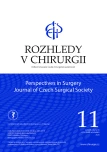What should a surgeon known about genetic background of thyroid cancer
Authors:
P. Bavor 1; B. Peková 2; V. Sýkorová 2; B. Bendlová 2; J. Hoch 1
Authors‘ workplace:
Chirurgická klinika 2. lékařské fakulty Univerzity Karlovy a Fakultní nemocnice Motol, Praha
1; Oddělení molekulární endokrinologie, Endokrinologický ústav, Praha
2
Published in:
Rozhl. Chir., 2020, roč. 99, č. 11, s. 481-486.
Category:
Review
Overview
Thyroid cancer is the most common endocrine malignancy, the treatment is multidisciplinary and multimodal. Thyroid tumors are heterogeneous in origin, morphology, biological behavior and therapeutic options. Substantial advances in diagnostic methods for thyroid cancer have led to detection of earlier stages of the disease that have the possibility of targeted therapeutic treatment and improved patient prognosis. In addition to surgical treatment, hormonal suppression and radioiodine therapy, targeted molecular therapy, which requires genetic testing, has come to the fore in recent decades. In the summary, we present an overview of current knowledge on the genetic background of individual types of thyroid carcinomas and the possibilities of therapeuticintervention.
Keywords:
tumors of thyroid gland − genetics
Sources
- Kopečková K. Nádory štítné žlázy. Praha, Mladá fronta 2019.
- Pekova B, Dvorakova S, Sykorova V, et al. Somatic genetic alterations in a large cohort of pediatric thyroid nodules. Endocrine connections 2019;8(6):796–805. doi:10.1530/EC-19-0069.
- Astl J. Chirurgická léčba nemocí štítné žlázy. Jesenius Maxdorf 2014.
- Paschke R, Cantara S, Crescenzi A, et al. European Thyroid Association guidelines regarding thyroid nodule molecular fine-needle aspiration cytology diagnostics. European Thyroid Journal 201;6(3):115–129. doi:10.1159/000468519.
- Astl J, Chovanec M, Lukeš P, et al. Thyroid carcinoma surgery in children and adolescents–15 years experience surgery of pediatric thyroid carcinoma. International Journal of Pediatric Otorhinolaryngology 2014;78(7):990–994. doi:10.1016/j.ijporl.2014.03.005.
- Agrawal N, Akbani R, Aksoy BA, et al. Integrated genomic characterization of papillary thyroid carcinoma. Cell 2014;159(3):676–690. doi:10.1016/j.cell.2014.09.050.
- Xing L. Genetic-guided Risk Assessment and Management of Thyroid Cancer. Endocrinology and Metabolism Clinics 2019;48(1):109–124. doi: 10.1016/j.ecl.2018.11.007.
- Xing M, Alzahrani AS, Carson KA, et al. Association between BRAF V600E mutation and recurrence of papillary thyroid cancer. Journal of Clinical Oncology 2015;33(1):42−50. doi:10.1200/JCO.2014.56.8253.
- Mehrzad R, Nishino M, Nucera C, et al. Invasive follicular variant of papillary thyroid cancer harboring the NRAS mutation Q61K and presenting with bone metastasis – A case report. International Journal of Surgery Case Reports 2018;38:180−184. doi:10.1016/j.ijscr.2017.06.067.
- Liu X, Qu S, Liu R, et al. TERT promoter mutations and their association with BRAF V600E mutation and aggressive clinicopathological characteristics of thyroid cancer. J Clin Endocrinol Metab. 2014;99(6):E1130−1136. doi:10.1210/jc.2013-4048.
- Paulson V, Rudzinski E, Hawkins D, et al. Thyroid Cancer in the Pediatric Population. Genes 2019;10:723. doi:10.3390/genes10090723.
- Su X, Li Z, He C, et al. Radiation exposure, young age, and female gender are associated with high prevalence of RET/PTC1 and RET/PTC3 in papillary thyroid cancer: a meta-analysis. Oncotarget 2016;7:16716−16730. doi:10.18632/oncotarget.7574.
- Yip L, Nikiforova MN, Yoo JY, et al. Tumor genotype determines phenotype and disease-related outcomes in thyroid cancer: a study of 1510 patients. Annals of Surgery 2015;262(3):519−525. doi:10.1097/SLA.0000000000001420.
- Yakushina V, Lerner L, Lavrov A. Gene fusions in thyroid cancer. Thyroid 2018;28:158−167. doi:10.1089/thy.2017.0318.
- Xing M. Clinical utility of RAS mutations in thyroid cancer: a blurred picture now emerging clearer. BMC Med. 2016;14:12. doi:10.1186/s12916-016-0559-9.
- Volante M, Rapa I, Gandhi M, et al. RAS mutations are the predominant molecular alteration in poorly differentiated thyroid carcinomas and bear prognostic impact. J Clin Endocrinol Metab. 2009;94(12):4735−4741. doi:10.1210/jc.2009-1233.
- Nikiforov Y. Molecular diagnostics of thyroid tumors. Arch Pathol Lab Med. 2011;135(5):569−577. doi:10.1043/2010-0664-RAIR.1.
- Sykorova V, Dvorakova S, Vcelak J, et al. Search for new genetic biomarkers in poorly differentiated and anaplastic thyroid carcinomas using next generation sequencing. Anticancer Research 2015;35(4):2029−2036.
- Pozdeyev N, Gay LM, Sokol ES, et al. Genetic analysis of 779 advanced differentiated and anaplastic thyroid cancers. Clinical Cancer Research 2018;24(13). doi:10.1158/1078-0432.CCR-18-0373.
- Roy M, Chen H, Sippel R. Current understanding and management of medullary thyroid cancer. The Oncologist 2016;18(10):1093–1100. doi:10.1634/theoncologist.2013-0053.
- Adnane L, Trail P, Taylor I et al. Sorafenib (BAY 43-9006, Nexavar), a dual-action inhibitor that targets RAF/MEK/ERK pathway in tumor cells and tyrosine kinases VEGFR/PDGFR in tumor vasculature. Methods Enzymol. 2006;407:597−612. doi:10.1016/S0076-6879(05)07047-3.
- Tirrò E, Martorana F, Romano C, et al. Molecular alterations in thyroid cancer: from bench to clinical practice. Genes 2019;10(9):709. doi:10.3390/genes10090709.
- Peková B, Sýkorová V, Dvořáková Š et al. RET, NTRK, ALK, BRAF, and MET fusions in a large kohort of pediatric papillary thyroid carcinomas. Thyroid 2020 [On line]. doi:org/10.1089/thy.2019.0802.
Labels
Surgery Orthopaedics Trauma surgeryArticle was published in
Perspectives in Surgery

2020 Issue 11
Most read in this issue
- Retrosternal goiter
- History of thyroid surgery
- What should a surgeon known about genetic background of thyroid cancer
- Papillary thyroid microcarcinoma and papillary thyreoid cancer at the Department of Surgery, EUC Clinic Zlín
